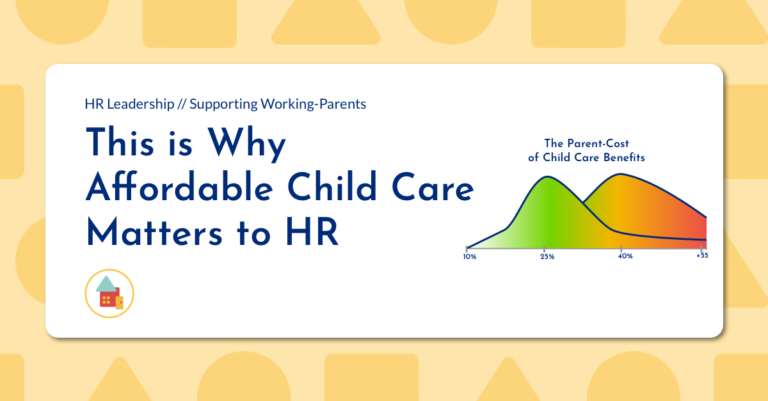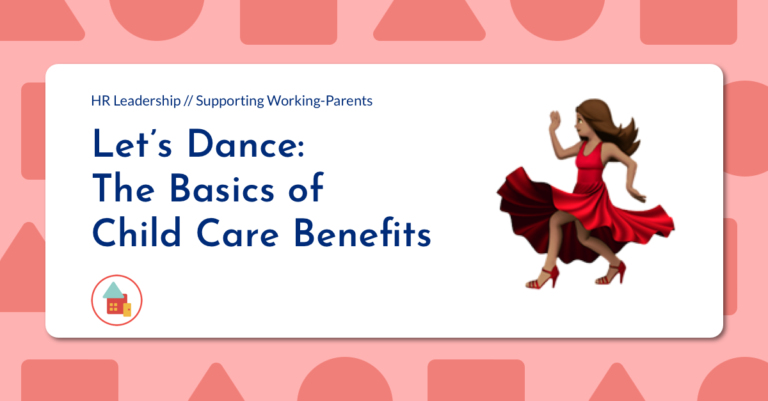If you’re leading PeopleOps / HR at a growth-stage startup, there’s a good chance that:
- you’re basically building everything from scratch, because you’re the first in the job
- your average age is under 30, and previous perks catered to the masses (read: free beer, pizza Fridays, etc.)
- you’ve been tasked with “keeping our culture strong” and “building a management layer” (at the same time!)
Sound familiar? If so, odds are that supporting working-parents is a relatively new priority, but Covid-19 has made it an issue you can’t ignore.

For teams under 1,000 FTE it’s easy for HR leaders to fall into the trap of thinking about working-parents by name: “I know Ashley and Sarah are out on maternity leave now, and Jason’s wife is expecting soon.” Don’t get me wrong, knowing your colleagues names is fantastic! These are major life milestones to celebrate, and sending that onesie with company colors is always adorable (pro tip: they might actually prefer a dinner delivery).
Unfortunately there are two pitfalls with this approach: first, it can lead you to undercount the total number of working-parents and think of them each as a series of one-off situations, instead of what they are: a distinct employee population with a unique set of priorities and needs. This makes it harder to prioritize the biggest opportunities for improvement for the population as a whole.
But second, and more damaging, this ignores the unknown number of your employees that might start a family in the next 2-4 years and are gauging your current support for their future plans. Do they see examples of new moms and dads coming back to work and kicking ass? If not, you can bet their taking note and thinking about more flexible options that will support their work-life goals.
When we think about each employee individually, it’s easy to excuse one mom’s choice not to come back after maternity leave because “well, she had that one special reason.” In reality, even today, 57% of women leave the workforce after the birth of their first child. Chalking up unwanted attrition to “special scenarios” is no excuse – if you have a mandate to support and advance gender equity in your workforce and leadership team, this is precisely when and where you need to step up. It’s harder to do that when thinking about names, not numbers.
But you’re a startup – what can you actually do? No, you’re probably not going to take the Patagonia approach and build an on-premise child care program staffed by full-time employees (think $ and space and time and legal and expertise).
Rather, here are 3 high-leverage opportunities for startups just getting started with child care benefits:
1. Family planning and pregnancy supports: startups like Maven Clinic and Ovia Health help employers recruit and retain parents by supporting this phase of life. Their network of experts help with fertility, pregnancy, and postpartum: everything they’ll need to feel supported right up until it’s time to come back from parental leave.
2. Affordable Full-Time Child Care: how long is your parental leave? 3 months? Ok, so when it’s time for Sarah to come back from maternity leave, who is going to look after her infant for the 40 – 50 hours a week that she works + commutes? Just a heads up: if the last mom you talked to about child care laughed and told you “oh, we’re piecing it together,” that’s not a real solution. “Piecing it together” is mom-talk for “this is stressful as hell and IDK whether it’s going to work.”
If you want your employees back at full productivity, they need full-time child care they can afford and feel good about. Many preschool centers don’t take infants this young, and those that do can be extraordinarily expensive. So typically at this age parents have two options: either a nanny or a home daycare. Nannies are the most expensive option and can stretch parents finances to the “child care tipping point” – assuming they can find one in the first place.
The alternative is home daycare; a small-scale child care program where a professional provider cares for just 5-6 kids at a time. Think of home daycare as the quality of care you’d find from an exceptional nanny or preschool teacher, with the cost shared by multiple families, and hosted in a home that has been converted and licensed for child care. Home daycares typically reserve two spots for infants, and are 50-60% less expensive than a nanny.
👉 See how startups partner with NeighborSchools to help working-parents find child care
One-Off Back-Up Care: as you explore traditional child care benefits, you’ll see that both Care.com and Bright Horizons sell one-off back-up programs. Employers contract with these vendors to offer parents a set number of back-up days each year that can be used on a one-off basis. A good option to include in your portfolio of benefits during normal times, these programs have struggled during Covid-19 when parents are nervous about bringing their children into large-scale centers, and are more focused on finding full-time child care so they can work their full-time jobs.
If you expect your best people to return from parental leave at full strength, don’t leave them to “piece it together” on child care. 🐣
Regardless of which of these areas you choose to focus on first, the important thing to remember is that you’re not too small to get started and there’s no better investment in the future of a gender-equitable organization than helping women in the transition to motherhood. If you’re ready to take the first step and explore your options, schedule a call with one of NeighborSchools child care benefits experts. On your intro call we’ll discuss your current priorities and initiatives, and sort out what makes sense given your current company size, trajectory, and aspirations.




